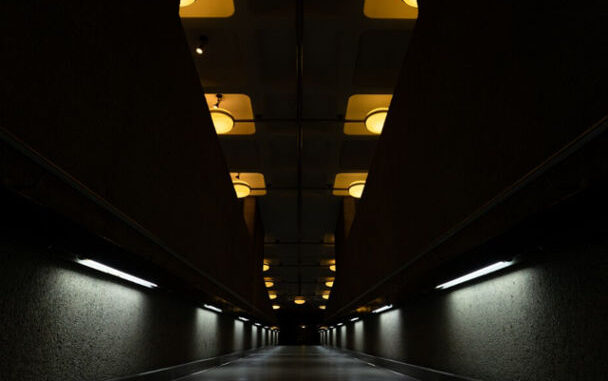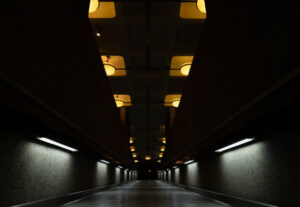
1. Introduction of Tunnel Lighting Design
Tunnel lighting is critical to ensuring the safety, visibility, and efficient operation of road and transportation tunnels. The design and implementation of tunnel lighting systems are essential components of overall infrastructure planning. Adequate tunnel lighting goes beyond illumination; it must address specific requirements to enhance driver perception, mitigate potential hazards, and provide a secure environment for all road users.
This introduction will delve into tunnel lighting design’s key considerations and requirements. The difficulties of tunnel lighting include dealing with the problems caused by low natural light and putting in place energy-saving technologies. To solve these problems, we need a complete plan that combines technical know-how, safety standards, and protecting the environment. As we learn more about the details of tunnel lighting design and requirements, it becomes clear that finding the best balance between safety, energy efficiency, and visibility is very important for tunnels to work well in the larger transportation network.
2. Importance of Proper Lighting
Proper lighting is paramount across various settings, particularly in tunnels. Proper illumination enhances safety by improving visibility, aiding emergency responses, and fostering driver comfort and confidence. Well-lit tunnels contribute to efficient traffic flow, ensuring compliance with safety standards and regulations. In essence, beyond mere visibility, proper lighting is foundational for safety, comfort, and operational effectiveness in diverse environments, including tunnels.

3. Factors Influencing Tunnel Lighting
A myriad of factors influence the design and implementation of tunnel lighting, each playing a crucial role in determining the effectiveness and efficiency of the illumination system. Understanding these factors is essential for creating a lighting solution that meets safety standards and optimizes tunnel visibility.
3.1 Tunnel Geometry: The tunnel’s shape and dimensions impact the light distribution. Factors such as tunnel width, height, and curvature influence how light spreads, requiring tailored lighting designs to ensure uniform illumination.
3.2 Traffic Conditions: The volume and speed of traffic within a tunnel influence lighting requirements. High-speed tunnels or those with heavy traffic may necessitate brighter lighting to maintain optimal visibility and safety.
3.3 Surface Materials: The reflectivity and color of tunnel surfaces affect how light is absorbed and scattered. Choosing appropriate materials can enhance the reflection of light, contributing to improved visibility.
3.4 Natural Light Conditions: Despite being limited in tunnels, daylight can still influence lighting needs. Strategies for integrating natural light and transitioning between day and night conditions are essential for energy efficiency and user comfort.
3.5 Emergency Scenarios: The lighting system must be designed to accommodate emergencies, ensuring that it remains functional even during power outages or evacuation scenarios.
3.6 Energy Efficiency: Considering the environmental impact and cost-effectiveness, the choice of lighting technology and its energy efficiency play a pivotal role. LED lighting, for instance, is often preferred for its energy savings and longevity.
3.7 Maintenance Accessibility: Ease of access for maintenance is crucial for ensuring that the lighting system remains in optimal condition. Factors such as the placement of fixtures and accessibility for repairs should be considered in the initial design.
3.8 Regulatory Standards: Compliance with national and international lighting standards and regulations is imperative. Adhering to established guidelines ensures tunnel lighting design’s safety and legal conformity.
3.9 User Experience: The psychological impact of lighting on users cannot be overlooked. A well-designed lighting scheme contributes to a positive user experience, promoting comfort and confidence during tunnel travel.
4. Types of Lighting Systems
Exploring the differences between traditional and LED lighting systems is essential. We’ll examine the benefits of LED technology, including energy efficiency and longevity, making it a preferred choice for modern tunnel lighting.
5. Key Components of Tunnel Lighting
Luminaires and control systems are the backbone of tunnel lighting. We’ll dissect their roles and importance in creating an effective and responsive lighting infrastructure.
6. Differences between Tunnel Lighting and Road Lighting
Tunnel Lighting vs. Road Lighting: Understanding the Differences
Tunnel lighting and road lighting serve distinct purposes, each tailored to meet their respective environments’ specific challenges and requirements. While both aim to enhance visibility and safety for drivers, pedestrians, and other road users, the characteristics of tunnels and open roads necessitate different approaches in their lighting design.
7. Enclosed vs. Open Environment:
- Tunnel Lighting: Tunnels are enclosed spaces with limited or no natural light. The focus is on providing consistent and adequate artificial lighting throughout the tunnel’s length to ensure continuous visibility for drivers.
- Road Lighting: Open roads operate in varying natural light conditions. Road lighting is designed to supplement natural light, providing illumination during nighttime or adverse weather conditions while adapting to the changing environmental brightness.
8. Uniformity of Illumination:
- Tunnel Lighting: Uniform lighting is crucial in tunnels to eliminate dark spots and shadows, ensuring consistent visibility. Special attention is given to preventing the “black hole” effect at tunnel entrances, where the eyes may struggle to adjust from bright outdoor light to tunnel darkness.
- Road Lighting: While uniformity is essential, road lighting allows for more flexibility in intensity. Lighting levels may vary to accommodate road curvature, intersections, and pedestrian zones.
9. Glare and Contrast Management:
- Tunnel Lighting: Managing glare is a critical consideration in tunnels, as excessive brightness or sudden changes in illumination can lead to discomfort and reduced visibility. The contrast between the tunnel interior and exterior lighting is carefully controlled.
- Road Lighting: Glare control is also important on open roads, but the focus is on minimizing glare for drivers from oncoming headlights, streetlights, and other light sources.
9.1 Emergency Scenarios:
- Tunnel Lighting: Tunnels require dedicated lighting solutions for emergency situations, ensuring continued visibility during power outages or evacuation scenarios. Emergency lighting systems are often integrated into tunnel lighting designs.
- Road Lighting: Emergency lighting on open roads is typically not as extensive, with reliance on vehicle headlights and, in some cases, specific road signage to guide drivers in emergency situations.
9.2 Environmental Factors:
- Tunnel Lighting: Tunnels are shielded from natural elements, allowing for more controlled lighting conditions. However, factors such as dust and humidity within tunnels may impact the performance of lighting fixtures.
- Road Lighting: Outdoor conditions, including rain, snow, and fog, influence road lighting requirements. Lighting fixtures on open roads must be designed to withstand exposure to various weather conditions.
10. What is the 40 m Length Rule for Tunnel Lighting
The 45m Length Rule for Tunnel Lighting is a guideline or standard used to design lighting systems for road tunnels. This rule suggests that for every 40 meters of tunnel length, there should be a transition zone at the entrance and exit of the tunnel where the lighting gradually adjusts to the changing environmental conditions.
The purpose of the 40m Length Rule is to address the visual adaptation challenges that drivers face when entering or exiting a tunnel. When drivers move from a well-lit exterior environment into a tunnel, or vice versa, a significant difference in brightness can momentarily affect their vision. This abrupt transition is known as the “black hole” effect, where the eyes take time to adjust to the change in lighting conditions.
The 45m Length Rule recommends a gradual transition zone at the tunnel entrance and exit to mitigate the black hole effect. During this zone, the lighting levels are incrementally adjusted to help drivers smoothly adapt to the changing light conditions, reducing the risk of temporary vision impairment.
11. Design Considerations
Balancing brightness with energy efficiency is an art. We’ll discuss design considerations that architects and engineers must consider to achieve optimal lighting without compromising sustainability.
12. Case Studies
Examining successful tunnel lighting implementations provides insights into real-world applications. Case studies showcase how innovative designs and technologies have been effectively integrated.
13. Benefits of Modern Designs
Modern tunnel lighting designs offer enhanced visibility and reduced energy consumption. We’ll highlight the advantages that come with embracing cutting-edge lighting solutions.
14. Challenges in Tunnel Lighting
While the benefits are substantial, challenges such as maintenance and cost considerations exist. We’ll address these challenges and provide strategies for overcoming them.
15. Innovations in Tunnel Lighting
Innovative lighting solutions are revolutionizing tunnel illumination. We’ll explore the latest innovations, including adaptive lighting and intelligent control systems.
16. Future Trends
Sustainability and adaptability are the future of tunnel lighting. We’ll discuss emerging trends in creating environmentally friendly and responsive lighting designs.
17. Lighting Control Strategies
Dynamic lighting is crucial for variable conditions. We’ll examine control strategies that ensure the adaptability of tunnel lighting to different scenarios.
18. Human-Centric Lighting
Enhancing the driver experience goes beyond safety. We’ll explore human-centric lighting approaches that prioritize the well-being and comfort of tunnel users.
19. Cost-Benefit Analysis
Long-term savings versus initial investment is a critical consideration. We’ll conduct a cost-benefit analysis to help decision-makers understand the economic implications of tunnel lighting projects.
20. FAQs
What are the requirements for tunnel lighting?
Requirements for tunnel lighting include ensuring uniform illumination, managing glare, and addressing emergency scenarios. Designs must consider factors like tunnel geometry, traffic conditions, and the reflectivity of surfaces. Compliance with standards, energy efficiency, and user experience are key. The lighting system should accommodate the transition between natural and artificial light, and accessibility for maintenance is crucial. Meeting safety standards and optimizing visibility in a tunnel’s unique environment are essential requirements for effective tunnel lighting.
What kind of lighting is used in tunnels?
LED lighting is commonly used in tunnels for its energy efficiency, longevity, and ability to provide uniform illumination. LED fixtures improve visibility, safety, and cost-effectiveness in tunnel environments.
What are the requirements for tunnel design?
Tunnel design requirements encompass safety, ventilation, lighting, and structural integrity. Considerations include traffic flow, emergency preparedness, and compliance with standards. Designs must address factors like geometry, material durability, and accessibility for maintenance. Overall, successful tunnel design balances functionality, safety, and adherence to regulations.
21. Conclusion
In conclusion, tunnel lighting design and requirements are integral to creating safe, efficient, and visually appealing tunnel environments. By understanding the complexities, embracing innovations, and adhering to standards, we can pave the way for a brighter and safer future in tunnel lighting.

Leave a Reply